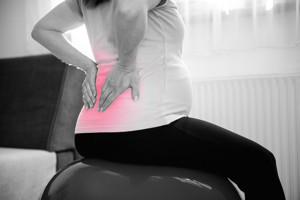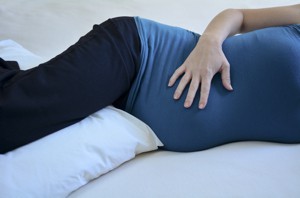 Aches and pains are a common complaint during pregnancy, thanks to the way your body expands and changes to make room for your growing baby and to prepare for labour. Sometimes, however, a problem can occur with your pelvis, commonly known as Symphysis Pubis Disfunction (SPD) or Pelvic Girdle Pain (PGP), which can result in significant pain and reduced mobility. We discuss what the condition is, and what you can do to help relieve the symptoms.
Aches and pains are a common complaint during pregnancy, thanks to the way your body expands and changes to make room for your growing baby and to prepare for labour. Sometimes, however, a problem can occur with your pelvis, commonly known as Symphysis Pubis Disfunction (SPD) or Pelvic Girdle Pain (PGP), which can result in significant pain and reduced mobility. We discuss what the condition is, and what you can do to help relieve the symptoms.
What Is SPD / PGP?
If you have been diagnosed, or think you might be suffering from SPD / PGP then it’s important not to panic, as the condition cannot harm your baby and many women make a full recovery following labour. The condition is caused by changes to the muscles and ligaments in your pelvic area, which is brought about by the hormone relaxin.
This hormone results in your ligaments becoming softer, making it easier for your baby to go through your pelvis during labour. For most women, this ligament softening doesn’t cause any problems. However, if you have a pre-existing problem, such as a joint imbalance, muscle irritation or fatigue, or a history of lower back problems, then the softening of your ligaments can cause your pelvis to become unstable and unable to properly support your body, resulting in pain.
What Are The Symptoms Of SPD / PGP?
 If you know someone else who is also suffering with SPD / PGP then you may not necessarily have the same symptoms. For example, you might have pain in one side of your hip, whilst your friend might have pain at the front of her pubic bone. Other areas that can be affected include your lower back (either both sides or just one side), and your perineum (the area between your vagina and anus). You may also develop symptoms similar to sciatica, which is where the pain can be felt down into one or both of your legs.
If you know someone else who is also suffering with SPD / PGP then you may not necessarily have the same symptoms. For example, you might have pain in one side of your hip, whilst your friend might have pain at the front of her pubic bone. Other areas that can be affected include your lower back (either both sides or just one side), and your perineum (the area between your vagina and anus). You may also develop symptoms similar to sciatica, which is where the pain can be felt down into one or both of your legs.
In addition, you may have a clicking sensation in your pelvic area when you move about. You are also likely to experience pain when trying to go about your normal routine, for example, when going upstairs, getting out of cars or your bed, or even doing the vacuuming.
What Treatment Is Available For SPD / PGP?
Discuss any symptoms with your midwife as soon as you start to notice them. Your midwife may refer you onto a physiotherapist, although this depends on what is available in your NHS trust area. The physiotherapist can give you a range of exercises to do that will help strengthen your muscles, which can bring pain relief. He or she will also be able to advise you about changes to your lifestyle and give you tips for labour. In more severe cases, crutches may be offered.
Paracetamol is safe to use during pregnancy, however, Ibuprofen (a non-steroidal anti-inflammatory drug (NSAID)) is not safe to use. If you think that you need additional pain medication you should consult with your doctor.
What Can I Do To Relieve Symptoms Of SPD / PGP?
 Try and avoid any strenuous activity as much as possible, particularly if you notice the symptoms getting worse. If you have a job that involves heavy manual labour then see if you can be assigned different tasks or discuss being signed off work with your GP. This also includes household tasks such as vacuuming or gardening. Even pushing a heavy trolley in the supermarket can leave you feeling sore for several hours after so avoid this if you can. Get help from your partner, friends or family.
Try and avoid any strenuous activity as much as possible, particularly if you notice the symptoms getting worse. If you have a job that involves heavy manual labour then see if you can be assigned different tasks or discuss being signed off work with your GP. This also includes household tasks such as vacuuming or gardening. Even pushing a heavy trolley in the supermarket can leave you feeling sore for several hours after so avoid this if you can. Get help from your partner, friends or family.
If you already have a toddler, try to avoid lifting them as much as possible and encourage them to do more things for themselves, for example, getting them to climb up the stairs etc. This is not always easy but anything you can do will make a difference to your level of comfort. At night time, try sleeping on your side with a pillow between your knees to give your pelvis extra support. You could try a pregnancy support pillow.
When you get up in the morning, roll onto your side so that you are facing the edge of the bed. Simultaneously push yourself up with your arms whilst keeping your knees together and bent and move your legs over the edge of the bed so that you end up in a seated position on the edge of the bed. Then slowly stand up. This is the least stressful way of getting out of bed for your joints, and you should follow the same principle when getting out of the car, i.e., keep your knees together and swivel both of your legs around out of the door before standing up. Make sure that you try and keep your knees close together wherever possible as this puts less stress on your pelvis.
Some women find that wearing a support belt can help relieve the symptoms. You may be able to get one from your physiotherapist, but if not, you can purchase them online. Make sure that you avoid staying in one position for too long. If you like to relax in front of the telly in the evening then get up and walk around during the ad breaks. If you have to stand for long periods for work, etc. then try to take regular breaks where you can sit down. Other pain relieving things you can try include:
- Swimming – Some women report that this can help relieve symptoms
- A heated wheat bag or ice pack placed on the affected area (avoid direct contact with the skin to prevent irritation / burning, etc.)
- Do your pelvic floor muscles – this will help you to recover faster after labour and strengthen your pelvic area
- Sit down to put your trousers, socks, etc. on, rather than standing on one leg, as this can aggravate the pain
- Wear flat, supportive and comfortable shoes – you have probably ditched those heels already, but if you haven’t then now is the time to do so
Labour and SPD / PGP
Labour is obviously painful, but adding SPD / PGP into the mix can make it even more unbearable. Talk to your midwife or physiotherapist about different birthing positions and think about what would work for you. For many women with SPD / PGP, giving birth in the traditional position where you are lying on your back in stirrups is not ideal.
For some women it may be better to give birth whilst kneeling on all fours, or in a birthing pool. Try and avoid positions that make the pain worse and if you have an epidural then make sure you know what your limits are, as it can be easy to overstretch your muscles and ligaments when you are unable to feel any pain.
